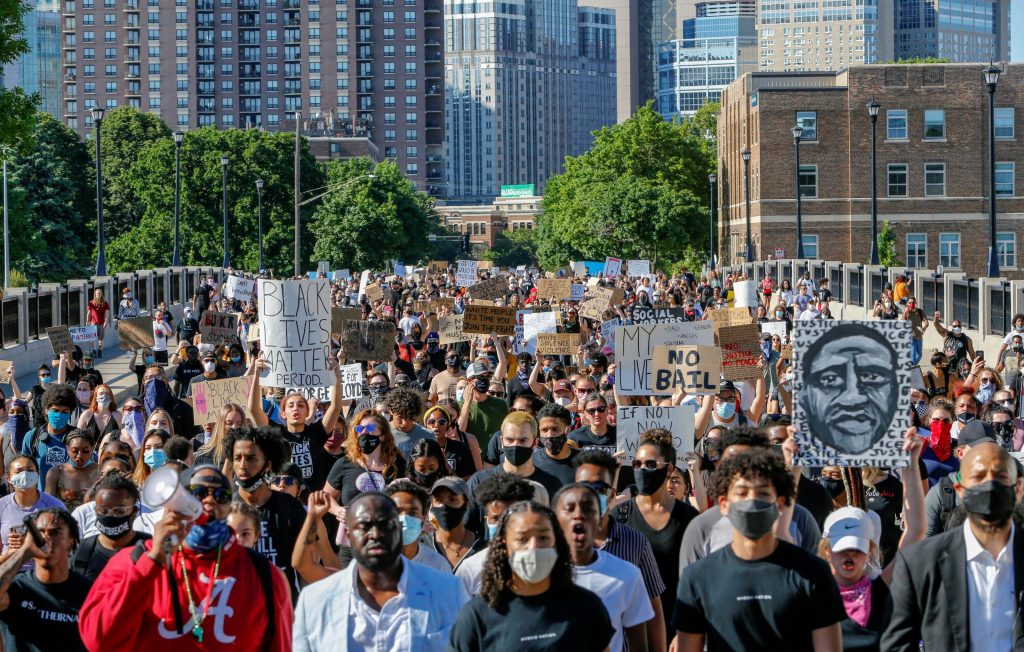
Over the past couple of decades, American cities replaced their abandoned downtowns with gleaming new residential developments, fancy restaurants, and office buildings with high-paying jobs.
On average, the economies of the biggest metro areas in the US doubled in size between 2001 and 2018, according to data from the Bureau of Economic Analysis.
But Black Americans were largely left out of the urban economic boom. From home ownership to income, they have consistently lagged behind their white counterparts. These disparities are adding fuel to the protests sparked by the death of George Floyd and other cases of police brutality.
“The dry tinder was racial and social inequality,” said Myron Orfield, director of the Institute on Metropolitan Opportunity, which focuses on race and poverty in metropolitan areas.
Not all neighborhoods benefited from the urban economic boom—and those that didn’t were more likely to have more Black residents, according to an analysis by Orfield’s group, which is part of the University of Minnesota Law School. It looked at residents’ income in the 50 most populous metro areas in the US to track how neighborhood fortunes changed between 2000 and 2016. It found that areas that underwent a strong economic expansion during that period also saw a surge in white residents. The number of Black residents in those areas, meanwhile, shrunk.
The opposite happened in neighborhoods that were in decline: The number of Black people living in them grew slightly, while the number of white residents dropped. Overall, Black people were much more likely to live in those areas than other groups.
Black Americans have also been disproportionally hurt by school segregation. In 2016, a typical white student attended schools in which nearly 70% of classmates were also white, according to a report published by the Civil Rights Project at the University of California, Los Angeles. The typical Black student, meanwhile, went to schools in which people of color made up 70% of the student body.
Schools with a high proportion of Black or Latino students also tend to have a high proportion of low-income students, research from Civil Rights Project shows. Since schools are heavily funded by local taxes, students living in poor neighborhoods receive less funding than those in better-off areas. The gap between white and non-white students was estimated to be $23 billion in 2019 by the education non-profit Edbuild.
In most US cities, students of color are much more likely to attend high-poverty schools than their white counterparts.
Despite the urban boom, Black homeownership over the past couple of decades didn’t improve much in most cities, and fell in others.
While the financial crisis wiped out gains in homeownership across the country, it’s been harder for Black homeowners to recover. This has made the gap between whites and Black Americans even wider in some metro areas. In St. Louis, for example, the black homeownership rate in 2000 was 48.5%, compared to 77% among whites. By 2017, Black homeownership had dropped to 38.6%. By comparison, white ownership in the city of more than 2.7 million people went up slightly, to 77.4%.
Individual incomes in more than 380 metro areas across the US grew an average of 15% between 2008 and 2018, according to analysis of data from the US Bureau of Economic Analysis. But in many cities, the median income of white residents grew significantly more than that of Black residents. For example, in the Dallas metro area, the median income for white residents grew by $18,480 between 2000 and 2018. By comparison, Black residents’ median income grew by $11,268.
In the top 50 most populous metro areas, Black residents continued to earn significantly less than white residents. In some cities, like Milwaukee, white residents earned more than double than their black counterparts in 2018.
These data points aren’t just isolated indicators of racial inequality, but part of a much larger problem. “It literally shows up in everything that we could look at,” says Valerie Wilson, an economist at the Economic Policy Institute who recently co-published a report with Elise Gould on how the Covid-19 pandemic disproportionately affected Black workers in the US due to racism.
Despite policies like financial assistance and lending support for small businesses, Gould and Wilson’s data analysis showed that racial discrimination, exclusion, and exploitation continue to be pervasive. Anti-discrimination laws haven’t worked very well either, because of lackluster enforcement, she adds.
Wilson says more transparency on pay and hiring decisions, clear pay scales, and pay ladders could help. She would also like to see more union organization. Whatever the policies are, they have to target the structural racism that is at the root of economic inequality, she said.
“It really does need to be informed by an acknowledgement of the underlying racial stratification and racial hierarchy in this country,” she added.